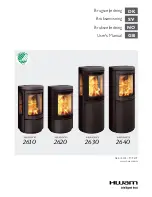
CHIMNEY TYPES - CANADA ONLY
The stove must be connected to an Underwriters
Laboratories of Canada Labelled Factory Built 650 C
Chimney, installed in accordance with the manufacturers
instructions or a lined Masonry Chimney, constructed
acceptable to the authority having jurisdiction.
CHIMNEY CONNECTOR
THE CHIMNEY CONNECTOR is a smokepipe used to
connect the 104 MK II Stove to the approved chimney
described above. The CHIMNEY CONNECTOR must be
made of CORROSION RESISTANT STEEL 24 gauge or
heavier (“black or blued” or equivalent treated steel).
SINGLE WALL STOVE PIPE MUST NOT PENETRATE
COMBUSTIBLE WALLS OR CEILINGS.
A 127mm to 153mm (5 to 6 inch) increaser is included in
the Stove kit. When using the 127mm to 153mm ( 5 to 6
inch) increaser, 153mm (6 inch) diameter connector pipe
is used. Be sure to fasten the chimney connectors
together and also to the flue outlet of the stove through
the two holes provided. Use at least two screws for each
joint. Be sure the joints are tight and fully secured.
CHIMNEY CONNECTOR USA ONLY
Connectors should maintain a pitch or rise of at least 1/4”
(6mm) to the foot from the stove to the chimney. It should
be installed so as to avoid sharp turns or other construc-
tion features that would create excessive resistance to
the flow of flue gases. It should be securely supported
with joints fastened with sheet-metal screws, rivets, or
other approved means. The entire length of a connector
should be readily accessible for inspection, cleaning and
replacement.
The connector may pass through walls or partitions con-
structed of combustible materials provided the connector
is either listed for wall pass-through or is routed through a
device listed for wall pass-through and is installed in
accordance with the conditions of the listing, NFPA 211 or
CAN/CSA - B365. Any unexposed metal that is used as
part of a wall pass-through system and is exposed to the
flue gases shall be constructed of stainless steel or other
equivalent material that will resist corrosion, softening, or
cracking from flue gas at temperatures up to 982
o
C
CONNECTING TO MASONRY CHIMNEY
The connector to a masonry chimney must extend
through the wall to the inner face or liner but not
beyond,and must be firmly cemented to masonry.
The connector may pass through walls or partitions con-
structed of combustible material to a masonry chimney
provided the connector system selected is installed in
accordance with the proper clearances and conditions.
(See figures 2, 3, 4, 5 & 6 pages 3 & 4).
THIMBLES
Thimbles for chimneys or vent connector should be of fire
clay (ASTM C 315, Specifications for Clay Flue Linings)
galvanised steel of minimum thickness of 24 gauge, or
material of equivalent durability. Thimbles should be
installed without damage to the liner. The thimble should
extend through the wall to, but not beyond, the inner face
of the liner and should be firmly cemented to masonry.
Thimbles should be located to provide adequate pitch or
rise of chimney or vent connectors and, where the ceiling
above the appliance is constructed of combustible mate-
rial, the location of the thimble should provide minimum
clearance required for the connector as specified in
Section under minimum clearances to combustibles.
Insulation material used as part of wall pass-through sys-
tem should be of non-combustible material and should
have a thermal conductivity of 1.0 Btu.in./ft.F
(4.88kg.cal/hr.m.C) or less. All clearances and thickness-
es are minimums; larger clearances and thicknesses are
acceptable. Any material used to close up an opening for
the connector should be of non-combustible material. A
connector to a masonry chimney, except for system 2
(Under heading Chimney Connector Systems, Thimbles
and Clearances), shall extend to piece through the wall
pass-through system and the chimney wall to the inner
face of the flue liner, but not beyond.
CHIMNEY CONNECTOR SYSTEMS, THIMBLES,
AND CLEARANCES FROM COMBUSTIBLE
WALLS
1.
Minimum 3 1/2” (90mm) thick brick masonry wall
framed into combustible wall with a min. of 12”
(305mm) brick separation form clay liner to com-
bustibles. Fire clay liner (ASTM C315 or equiva
lent) min. 5/8” (16mm) wall thickness, should run
from outer surface of brick wall to, but not
beyond, the inner surface of chimney flue liner
and should be firmly cemented in place.
3
Fig.2
Minimum clearance 12” (305mm) of brick
Minimum 12” (305mm)
to combustibles
Minimum chimney clearance
to brick and combustibles 2” (50mm)





























